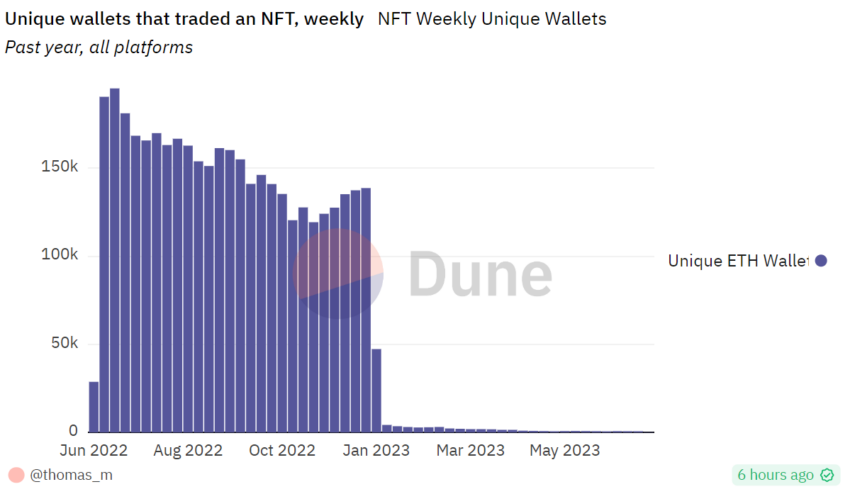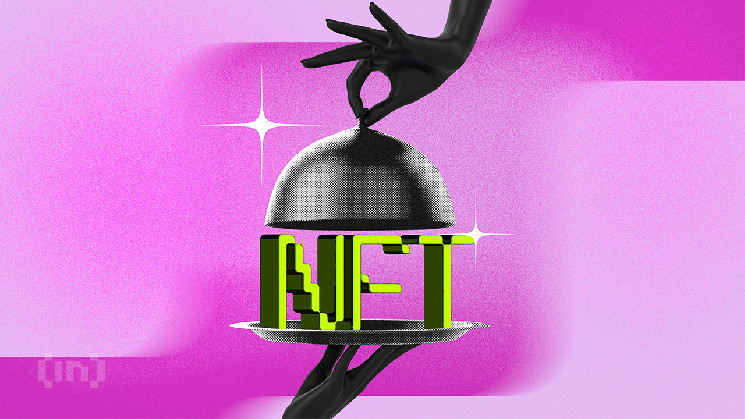Non-fungible tokens have come a long way, in the view of Anjali Young, the co-founder and COO of Abridged. In a BeInCrypto interview, Young pointed to the June 15 auction of “The Goose” NFT at Sotheby’s as a bullish sign. While the fine art NFT market faces myriad challenges, inaccurate valuation not least among them, Young sees blockchain transparency as an advantage.
2019 was the final stretch before a pandemic. For Web3 and crypto, it was also the year that introduced the mass public to non-fungible tokens (NFTs). One of the first to catch on was NBA’s Top Shot. After an explosion in popularity in early 2021, NBA Top Shot surpassed CryptoKitties and Decantraland to become the world’s largest NFT market.
Sotheby’s Auction a Bullish Sign
By 2021, the market had matured significantly. Legendary auctioneer Sotheby’s was selling NFTs for $17 million as denizens of the art world turned up to watch.
By the end of the year, the legendary auction house had made over $100 million just by selling digital collectibles, according to their own figures. At the time, their endorsement signaled the transition of NFTs from a passing fad to prestigious digital artwork.
In October of that year, Sotheby’s even launched its own marketplace—Sotheby’s Metaverse.
However, that was before the bear market. Yet, even as interest in NFTs has fallen by 95% from its January 2022 peak, according to Google Trends, the art and fashion worlds are two cliques that have continued to take them seriously.
Generative artist Dmitri Cherniak’s Ringers “The Goose” NFT sold for a hammer price of $5.4 million at Sotheby’s last month, the second highest ever for a digital collectible.
Young views recent Sotheby’s auction figures as a sign of the NFT market’s robustness. The sales bring positive attention from outside, she said.
“Leading up to the auction, Sotheby’s estimated that ‘The Goose’ would fetch a price between $2-3 million. By closing at $6.2 million and blowing its original 2021 sale price out of the water, ‘The Goose’ exceeded all expectations,” Young continued.
“Having these types of wins during a bear market is a validation for the staying power of this unique art form, in a way that many high-valuation sales made during yesteryear’s peak NFT mania did not fully capture,” she added.
NFTs Have Their Own Culture, Says Anjali Young
In August 2021, 3AC co-founders Su Zhu and Kyle Davies bought “The Goose” for about 1,800 ETH. A figure worth approximately $5.8 million at the time. In the recent Sotheby’s auction, it went to a pseudonymous NFT collector called 6529.
“The fact that ‘The Goose’ has been reabsorbed into the NFT community from a now-defunct hedge fund shows the passion and conviction of the artists and collectors in the space,” observed Young.
“To this point, the buyer has expressed his belief that important crypto-cultural markets should stay natively in decentralized spaces. This is why ‘The Goose’ was collectively purchased via an on-chain museum, and this recent auction shows that crypto has its own culture. One that should be celebrated and shared even outside of our narrow borders.”
But the recent Sotheby’s auction is one-half of two stories. Because regardless of the exciting subculture of NFTs, or the occasional auction story that bursts into the mainstream press, NFTs are old news. At least for most people.
According to data from Dune, the weekly numbers of wallets trading Ethereum NFTs collapsed in January 2023, and has never recovered. NFT trading is firmly a minority pursuit—at least for now.

Fashion Has Stuck Around
However, according to Young, the recent Sotheby’s event did not focus solely on resale value. So perhaps those fixating on record-breaking prices are missing the point?
“Conversations mostly revolved around the sheer beauty and impact of what it means to be at this special intersection of art, tech, and community. Not so much the constant talk of floor prices some might expect after reading media coverage of the auction,” she said.
Young also sees potential for the sector as fashion brands have entered (and then stayed) in the space. Demonstrating that, at least in the eyes of some, NFTs are no passing fad.
“During [my recent] visit to Europe, I noticed a growing excitement around brands and NFTs outside the US,” Young said. “We are beginning to see luxury fashion brands like Gucci, Louis Vuitton, and Lacoste embrace NFTs, and there are many more waiting in the sidelines learning and eager to join when the time is right for them.”
Learn more about unique digital collectibles and their potential: NFTs Explained: What Are Non-fungible Tokens and How Do They Work?
At the same time, Young also sees considerable barriers to NFTs’ wider adoption. One of them being education.
Does the Average Joe fully understand what they are, beyond expensive JPEGs of monkeys? She remains skeptical.
“I wouldn’t say the basic concept of NFTs is as widely understood as it could be. Cultural and educational barriers to their adoption certainly exist all over the world. These are areas we need to focus on as we strive to make NFTs more mainstream.”
A More Transparent Market
One of the gnawing concerns about NFTs and the market surrounding them is price accuracy. How do investors know what they’re buying is a “quality” NFT? How do you know you’re not buying into an over-hyped collection that will soon be eclipsed by the next flavor of the month?
For comparison, high-end art is widely acknowledged to be one of the most manipulated markets in the world. And one that favors keeping the price of established artists (whose artwork is already in the collections of the uber-wealthy) at very high levels.
How is the NFT market any different when we don’t even know the identity of the pseudonymous trader 6529?
“Inaccuracies exist in all kinds of valuations, from real estate to corporate stocks,” conceded Young. “There’s no absolute measure of truth in any of these domains. The advantage with NFTs and other crypto assets, however, is that all transactions are openly visible on the blockchain.”
Young sees the level of transparency that comes into play here as without precedent.
“While it’s true that there’s no foolproof method to determine value, this level of transparency places us on a more advantageous trajectory compared to many other markets.”
NFTs Are More Than Art
“The value of art will always be financially subjective and societally priceless,” Young said.
As 6529 aptly put it, long-form on-chain generative art is magical in the sense that, “unlike almost any other art form, neither the artist nor the initial collector know what the piece will be at the moment it is collected.”
Although, the focus shouldn’t always be on NFTs as art or speculative assets, said Young. Part of the education deficit with NFTs is the lack of understanding about how they are so much more.
“They’re already being utilized in a variety of ways,” said Young. “From serving as memberships to online clubs, to being integrated into gaming, to providing access to exclusive real-life events. They are also used as proof of participation and attendance, loyalty points, and even as elements of digital identity.”
 beincrypto.com
beincrypto.com
